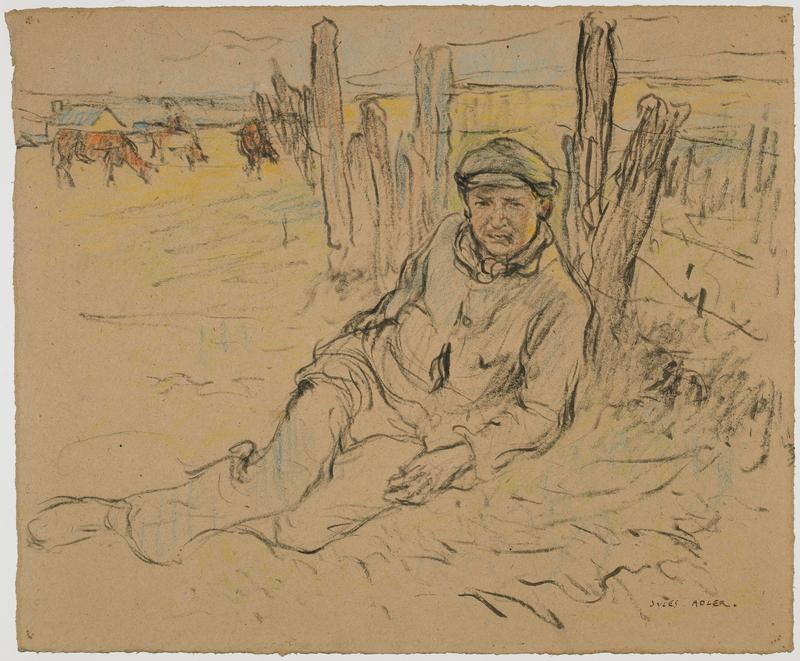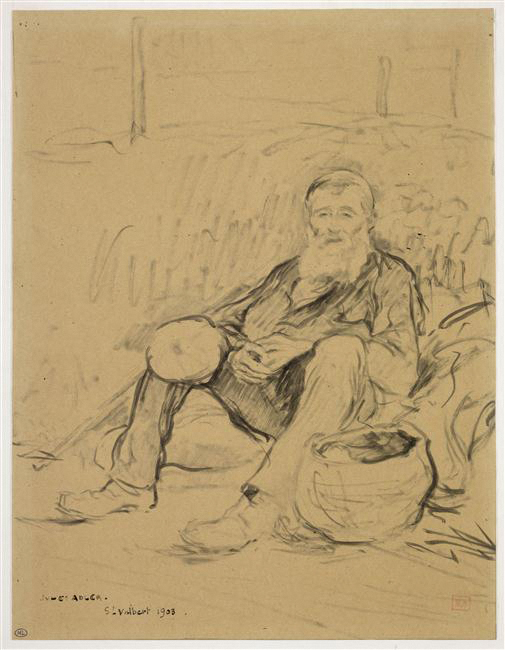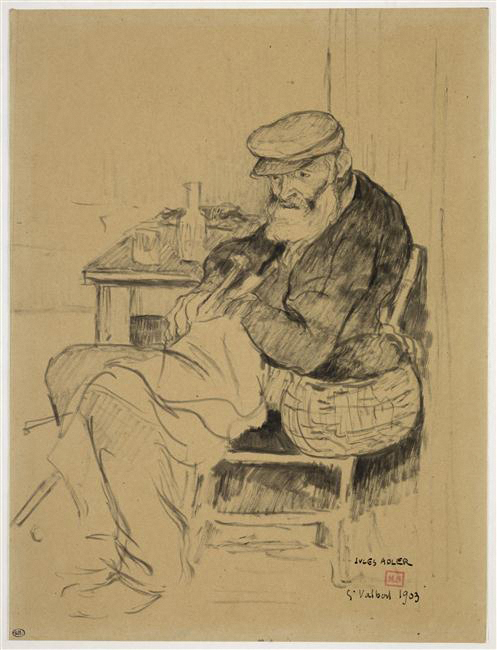
3. Jules Adler, Vagabond Seated in a Field
| Artist | Jules Adler, French, Luxeuil-les-Bains 1865–Nogent-sur-Marne 1952 |
| Title, Date | Vagabond Seated in a Field (Chemineau assis dans un champ), c. 1900–1909 |
| Medium | Brush and black ink, charcoal, and pastel on tan paper |
| Dimensions | 11 1/8 × 13 3/8 in. (28.3 × 34 cm) |
| Inscriptions + Marks | Lower right: JULES ADLER |
| Provenance | [Neal Fiertag, Paris, until 1994; to Weisberg]; Yvonne and Gabriel Weisberg, Minneapolis |
| Exhibition History | "Exposition des oeuvres de J. Adler," Salle d’Exposition Dalpayrat Frères, Limoges, France, 1908, no. 24; "The Quieter Image: 19th Century European Drawings and Watercolors," Carleton Art Gallery, Carleton College, Northfield, Minn., 1996, no. 16; "Expanding the Boundaries: Selected Drawings from the Yvonne and Gabriel P. Weisberg Collection," Mia (2008) and Snite Museum of Art, Notre Dame, Ind. (2010); "Reflections on Reality: Drawings and Paintings from the Weisberg Collection," Mia, 2022–23 |
| References | Georges Denoinville, "Jules Adler," "L’Art et les Artistes," vol. 9 (April–September 1909), pp. 213–17, ill.; Lisa Dickinson Michaux with Gabriel P. Weisberg, "Expanding the Boundaries: Selected Drawings from the Yvonne and Gabriel P. Weisberg Collection" (exh. cat.), Minneapolis Institute of Arts (Minneapolis, 2008), pp. 40, 42, fig. 22 |
| Credit Line | Promised gift of Gabriel P. and Yvonne M.L. Weisberg, Minneapolis |
The influential French critic Louis Vauxcelles (1870–1943) dubbed Jules Adler le peintre des humbles—painter of the humble. This may be surprising considering Adler’s reputation for large paintings of urban life. But he found subjects in the countryside, too.


Starting in the 1870s, rural France faced challenges that led to change and displacement. Crop prices dropped, products arriving from the colonies created new competition, and phylloxera devastated the vineyards. Traditional family farms that raised a variety of plants and animals began to give way to industrial-scale, mechanized monoculture. Many people left for the cities or wandered the roads looking for work. Adler’s hometown, in the Haute-Saône département, or county, in eastern France, experienced steady population decline from about 1877 until 1945, losing about a third of its residents.
Adler was given to quick ink sketches, which seems to have suited his encounters with vagabonds from the 1890s onward. The figure in the present drawing rests on the ground, his back propped against a fence, his eyes staring forlornly into space. His clothes are not that of a farmworker but rather a factory worker who may have lost his job in the city. Two other drawings of vagabonds by Adler (figs. 1–2), both at the Louvre, note the place where he saw them: St. Valbert, not far from his birthplace of Luxeuil-les-Bains.
The son of a cloth merchant, Adler studied under William-Adolphe Bouguereau, P. A. J. Dagnan-Bouveret (cat. nos. 61–62), and Tony Robert-Fleury. Adler became a member of the Salon des Artistes Français and eventually served on the group’s organizing committee and the jury. He exhibited in the Salon d’Automne, the Salon des Tuileries, and several international venues, often to acclaim. His drawings appeared in a number of exhibitions, but it remains unclear whether the present sheet was ever among them. He was made a knight of the Legion of Honor in 1907 and an officer in 1923.
GPW and TER